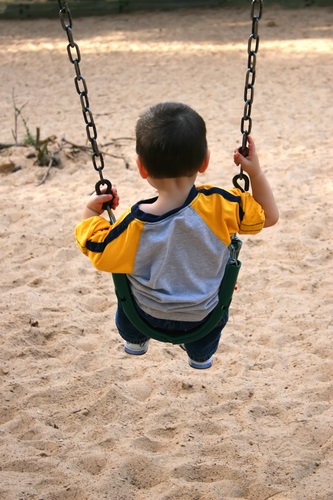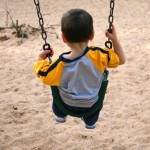Jimmy, a 5 ½ year old boy with autism, was transitioning to kindergarten. This non-verbal child with a hyper-reactive sensory system would be leaving our self-contained university-based preschool special education program and heading back to his home school district. For about a year, Jimmy had been spending part of his week in a private general education preschool classroom with the support of our staff. This opportunity to learn alongside his typically developing peers enhanced his engagement and play skills. Buoyed by the power of inclusion, Jimmy’s parents were strong proponents of his inclusion in a general education kindergarten classroom in his school district. The staff in the district knew Jimmy’s diagnosis and had observed him squeezing his arms and making loud “eee” sounds frequently throughout the day. They knew Jimmy as a child with autism and they did not agree with the placement in a general education kindergarten classroom.
This push back about including Jimmy is understandable when you examine the international research literature on teacher’s beliefs about including students diagnosed with autism. Teachers believe that students with autism require the most significant accommodations and are substantially more difficult to include in general education classes than students with other disabilities (Cook, 2001; Sansosti & Sansosti, 2012; Stoiber, Gettinger, & Goetz; 1998). The literature also reveals that general education teachers—both pre-service (Barned, Knapp, & Neuharth-Pritchett, 2011; Busby, Ingram, Bowron, Oliver, & Lyons, 2012; Doody & Connor, 2012) and in-service (Cook, 2001; Humprhey & Symes, 2013; Lindsay, Proulx, Thomson, & Scott, 2013; Stoiber et al., 1998; Teffs & Whitbred, 2009) believe they lack adequate understanding of students with autism. Finally, the two diagnostic criteria for autism (repetitive, unusual behaviors and challenges with social communication) are the characteristics that general education teachers find most challenging (Al-Shammari, 2006; Arif, Niazy, Hassan & Ahmed, 2013; Busby et al., 2012; Drysdale,  Williams, & Meany, 2007; Helps, Newsom-Davis, & Callias, 1999; Humphrey & Symes, 2013; McGregor & Campbell, 2001; Robertson, Chamberlain, & Kasari, 2003, Rodriguez, Saldaña, & Moreno, 2012; Segall & Campbell, 2012; Teffs & Whitbred, 2009).
Williams, & Meany, 2007; Helps, Newsom-Davis, & Callias, 1999; Humphrey & Symes, 2013; McGregor & Campbell, 2001; Robertson, Chamberlain, & Kasari, 2003, Rodriguez, Saldaña, & Moreno, 2012; Segall & Campbell, 2012; Teffs & Whitbred, 2009).
These types of beliefs impacted the district’s decision to support Jimmy’s transition to a general education classroom. Our interdisciplinary team as well as Jimmy’s parents had worked collaboratively for two years so that we could understand Jimmy and attune to his internal state rather than his overt behaviors (Schore, 2001). Using transdisciplinary practices we had focused on developing Jimmy’s capacity to experience, regulate (manage), and express emotions; form close and secure interpersonal relationships; explore and master the environment and learn. So how were we going to share all of this information? How could we turn this transition into a teachable moment for the staff in the school district?
At that time, I was enrolled in an infant mental health certificate program and was immersed in reading seminal pieces that used first-person narrative to help the reader gain an enhanced understanding of the child’s internal life (Fraiberg, Adelson & Shapiro, 1975; Carter, Osofsky & Hann, 1991; Stern, 1990). I decided to use this strategy to help the district’s team attend to the numerous sensory, motor, and affective behaviors in a way that might allow them to think about why Jimmy was or was not doing something, or how he might be feeling when he was not engaged. A few days before the transition-planning meeting I wrote a profile of Jimmy from his perspective as I, my teammates and Jimmy’s parents understood it.
Hello, my name is Jimmy and I’m 5 and ½ years old. I can’t make too many words to communicate with other people and this is very frustrating for me because I know a lot of things and have ideas about what I want to do. Sometimes I will look at someone, point to an object or nod my head to tell others that I need something or to answer a question. I’m getting better at using pictures and a few words to stand for ideas in my head.
When people ask me questions and I can’t respond it makes me feel uncomfortable. Many times I have to grab my arms, squeeze my body and make a loud “eee” sound when I feel like this. I usually need help answering the questions or at least I need a choice of pictures so I can show them my answer.
I feel better when I get to do things with my body like jumping, climbing or crawling before I have to sit down to work or to be part of a group. It makes my body feel calmer and I feel like I am stronger and can do more things with my hands and fingers.
I am most comfortable when things are familiar to me and I know what is going to happen next. For example, I know that after I play in the morning we will have circle time. Then I will wash my hands and sit at the table for snack. Sometimes things change. It really helps when people tell me and show me what will be different. They usually use the picture schedule. When things are really different and nobody tells me ahead of time I get scared and confused. I might cry or fall down or kick. I might even go to the window and look outside. I need to get away from everything that is confusing me. I really don’t know what to do or how to tell people how confused I am.
I really love writing my name on things I have made; it shows everyone it is mine. It helps when people remind me to write darker or when someone puts boxes on the paper for each letter. I like letters and I know them all and can even put them in alphabetical order. I can read some words like my classmates’ names.
I like being around other kids my age. It is fun to watch what they are doing. Sometimes I even try to copy them but lots of times I can’t do that by myself. I want to tell them, “Please understand me and slow down. I am trying really hard and I want to learn.”
Jimmy was included in a general education kindergarten where his parents used this profile to explain Jimmy to his classmates and their parents. They helped all the new people in Jimmy’s life look at his behaviors through a lens of understanding rather than through the lens of autism. Similar to our interdisciplinary team, his new teachers worked hard to understand Jimmy’s hyper-reactive sensory system and delayed motor planning as the sources of his “unusual” behaviors and limited verbal communication. Over the years I have used this exercise of writing first person profiles of young children as a transition tool for schools, as the foundation of a parent workshop series and as part of my teaching in the field of teacher education (Catalano, Hernandez & Wolters, 2002).
This reframing is theoretically grounded in the work of Stanley Greenspan (2006) and is currently part of the brilliant Self-Reg™ framework developed by Stuart Shanker (2015) which is a practical paradigm through which parents, teachers and other allied professionals can better understand children as well as themselves (www.self-reg.ca). Adults with autism who are able to communicate are helping us think differently about young children who struggle with social communication and have repetitive patterns of behavior (Fleischman & Fleischman, 2012; Grandin & Panek, 2013). Rather than viewing a child’s behavior as a criteria for a diagnosis, early childhood professionals and parents must wonder about what each behavior tells us about a child’s inner life. Many voices are asking us to inquire within each unique individual and reexamine how we understand autism (Donvan & Zucker, 2016; Hamlin, 2016; Prizant, 2015; Whitman, 2004; Silberman, 2015).
For more information visit the Center for Autism and Early Childhood Mental Health at Montclair State University.
References
Al-Shammari, Z. (2006). Special Education Teachers’ Attitudes Toward Autistic Students in the Autism School in the State of Kuwait: A Case Study. Journal of Instructional Psychology, 33(3), 170-178.
Arif, M.A., Niazy, A., Hassan, B. & Ahmed, F. (2013). Awareness of Autism in Primary School Teachers. Autism Research and Treatment, 2013, 1-5. doi: 10.1155/2013/961595
Barned, N. E., Knapp, N. F., & Neuharth-Pritchett, S. (2011). Knowledge and attitudes of early childhood pre-service teachers regarding the inclusion of children with autism spectrum disorder. Journal of Early Childhood Teacher Education, 32(4), 302-321. doi: 10.1080/10901027.2011.622235
Busby, R., Ingram, R., Bowron, R., Oliver, J., & Lyons, B. (Winter 2012). Teaching elementary children with autism; addressing teacher challenges and preparation needs. Rural Education, 27-35.
Carter, S.L., Osofsky, J.D., & Hann, D.M. (1991). Speaking for the baby: A Therapeutic intervention with adolescent mothers and their infants. Infant Mental Health Journal, 12 (4), 291-301.
Catalano, C.G., Hernandez, P.R., & Wolters, P. (2002). Who am I?: A child’s self-statement. Exceptional Parent Magazine, April, 60-65.
Cook, B. G. (2001). A comparison of teachers’ attitudes toward their includedstudents with mild and severe disabilities. The Journal of Special Education, 34(2), 203-213. doi: 10.1177/002246690103400403
Donvan, J. & Zucker, C. (2016). In a Different Key: The Story of Autism. New York, NY: Crown Publishing.
Doody, O. & Connor, M.O. (2012). Influence of teacher practice placement on one’sbeliefs about intellectual disability: a student’s reflection. British Journal of Learning Support, 27 (3), 113-118. doi: 10.1111/j.1467-9604.2012.01523.x
Drysdale, M. T. B., Williams, A., & Meany, G.J. (2007). Teachers’ perceptions ofintegrating students with behavior disorders: challenges and strategies, Exceptionality Education Canada, 17(3) pp.35-60.
Fleischman, A. & Fleischman, C. (2012). Carly’s Voice: Breaking Through Autism. New York, NY: Touchstone/Simon & Schuster.
Fraiberg, S., Adeleson, E. & Shapiro, V. (1975). Ghosts in the nursery: A psychoanalytic approach to the problem of impaired infant mother relationships. Journal of the American Academy of Child Psychiatry, 14, 387-422.
Grandin, T. & Panek, R. (2013). The Autistic Brain: Thinking Across the Spectrum. Arlington, TX: Future Horizons.
Greenspan, S.I. & Wieder, S. (2006). Engaging Autism: Using the Floortime Approach to Help Children Relate, Communicate and Think. Cambridge, MA: A Merloyd Lawrence Book.
Hamlin, T. (2016). Autism and the Stress Effect: A 4-Step Lifestyle Approach to Transform Your Child’s health, Happiness and Vitality. Philadelphia, PA: Jessica Kingsley Publishers.
Helps, S., Newsom-Davis , I. C., & Callias, M. (1999). Autism: The teacher’s view. Autism, 3: 287-298. doi: 10.1177/1362361399003003006
Humphrey, N. & Symes, W. (2013). Inclusive education for pupils with autistic spectrum disorders in secondary mainstream schools: teacher attitudes, experience and knowledge. International Journal of Inclusive Education, 17(1), 32–46. doi:10.1080/ 13603116.2011.580462
Lindsay, S., Proulx, M., Thomson, N. & Scott, H. (2013). Educators’ challenges of including children with autism spectrum disorder in mainstream classrooms. International Journal of Disability, Development and Education, 60(4), 347-362. doi:10.1080/ 1034912X.2013.846470
McGregor, E., & Campbell, E. (2001). The attitudes of teachers in Scotland to the integration of children with autism into mainstream schools. Autism, 5, 189-207. doi: 10.1177/1362361301005002008
Prizant, B.P. (2015). Uniquely Human: A Different Way of Seeing Autism. New York, NY: Simon & Schuster.
Robertson, K., Chamberlain, B., & Kasari, C. (2003). General education teachers’ relationships with included students with autism. Journal of Autism and Developmental Disorders, 33(2), pp. 123-130.
Rodríguez, I. R., Saldaña, D. and Moreno, F. J. (2012). Support, inclusion and special education teachers’ attitudes toward the education of students with autism spectrum disorders. Autism Research and Treatment, 1-8. doi:10.1155/2012/259468
Sansosti, J.M., & Sansosti, F.J. (2012). Inclusion for students with high-functioning autism spectrum disorders: Definitions and decision-making. Psychology in the Schools, 49(10), 917-931. doi: 10.1002/pits.21652
Schore, A. (2001). Effects of a secure attachment relationship on right braindevelopment, affect regulation, and infant mental health. Infant Mental Health Journal. Michigan Association for Infant Mental Health, 22 (1-2), 7-66.
Segall, M.J., & Cambell, J.M. (2012). Factors relating to education professionals’ classroom practices for the inclusion of students with autism spectrum disorders. Research in Autism Spectrum Disorder, 6, 1156-1167. doi: 10.1016/j.rasd.2012.02.007
Shanker, S. (2015). www.self-reg.ca.
Silberman, S. (2015). NeuroTribes: The Legacy of Autism and the Future of Neurodiversity. New York, NY: Penguin Random House.
Stern, D.N. (1990). Diary of a Baby. New York: Basic Books.
Stoiber, K. C., Gettinger, M., & Goetz, D. (1998). Exploring factors influencing parents’ and early childhood practitioners’ beliefs about inclusion. Early Childhood Research Quarterly, 13(1), 107-124. doi: 10.1016/S0885-2006(99)80028-3
Teffs, E., & Whitbread, K. (2009). Level of preparation of general education teachers to include students with autism spectrum disorders. Journal of Current Issues in Education,12(10), retrieved from http://cie.asu.edu/ojs/index.php/cieatasu/article/view/172/4. Date accessed: 01 Jul. 2014.
Whitman, T.L. (2004). The Development of Autism: A Self-regulatory Perspective. New York, NY: Jessica Kingsley Publishers.
 In contrast, parents who come to a private practice setting are generally seeking services voluntarily. They may be scared, confused, and/or overwhelmed by the challenges that they face in parenting. They seek guidance regarding particular concerns, new ideas, and answers to specific questions. At such times, the most supportive response is to offer expert guidance that can reduce their distress by offering hope that the challenges that they face can be managed.
In contrast, parents who come to a private practice setting are generally seeking services voluntarily. They may be scared, confused, and/or overwhelmed by the challenges that they face in parenting. They seek guidance regarding particular concerns, new ideas, and answers to specific questions. At such times, the most supportive response is to offer expert guidance that can reduce their distress by offering hope that the challenges that they face can be managed.



